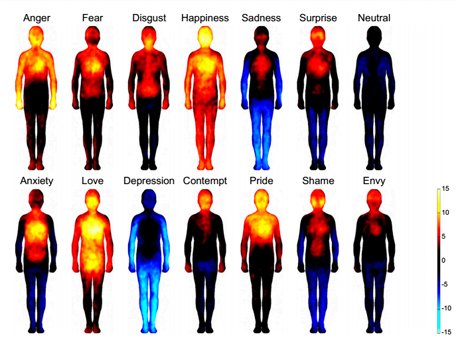‘Body maps’ show where we feel love, anger, shame
A group of scientists have now proven that old sayings such as being ‘sad and depressed’ can really make you blue, and are being angry is enough to make you see red. Not to mention that feeling of butterflies in your stomach, while on the first date. A group of researchers from Finland have created heat maps that highlights where on the body emotions are being experienced. The aim of the study was to discover whether there is actually a consistent connection across various groups and geographical locations between what human beings feel in terms of emotion and the physical sensation that accompanies that feeling.
During five experiments, participants were shown to silhouettes of bodies alongside emotional words movies stories of facial expressions and were then asked to color which bodily regions they felt activity was increasing or decreasing, while viewing the stimulus provided. Different emotions were consistently associated with statistically separable bodily sensation maps across the experiments the report said.
The study noted that many of the basic emotions involved increased activity in the upper chest region was, “likely corresponding to changes in breathing and heart rate”. Sensations in the upper limbs tended to go hand in hand with “approach-oriented emotions, such as anger and happiness”, while decreased, “heavy” limbs related to sadness.The link between emotions and bodily states is reflected in the way human beings speak of emotions. For example a young nervous bride getting married shortly might certainly have ‘cold feet’, while star-crossed lovers disappointed in relationships may be ‘heartbroken’ and our favorite tune can still send ‘shivers down the spine’.
Almost all of the emotions generated changes in the head area, suggesting smiling, frowning, or skin temperature changes, while feelings like joy and anger saw mapping in the limbs. I find it interesting that shame generated those glows around the eye region. Perhaps the saying, ‘I cant look you in the eye’? Meanwhile, “sensations in the digestive system and around the throat region were mainly found in disgust,” the team wrote. As The Atlantic reported “It’s worth bearing in mind that the bodily sensations were not blood flow, which could be measured objectively, instead they were based solely on physical twinges, participants recorded they experienced”.
The Finnish team cautioned that the maps are imperfect and more research needs to be carried out, but think the research could be used in the diagnosis and treatment of emotional disorders.

Hayden Richards is Contributor of IntelligentHQ. He specialises in finance, trading, investment, and technology, with expertise in both buy-side, sell-side. Contributing and advising various global corporations, Hayden is a thought leader, researching on global regulatory subjects, digital, social media strategies and new trends for Businesses, Capital Markets and Financial Services.
Aside from the articles, interviews and content he writes for IntelligentHQ, Hayden is also a content curator for capital markets, analytic platforms and business industry emerging trends. An avid new media explorer Hayden is driven by a passion for business development, innovation, social business, Tech Trading, payments and eCommerce. A native Trinidadian, Hayden is also a veteran, having served with the Royal Air Force Reserves for the past 10 years.
Follow Hayden on Twitter @HaydenARichards, linkedin.com/haydenhrichards and http://www.scoop.it/u/hayden-richards












